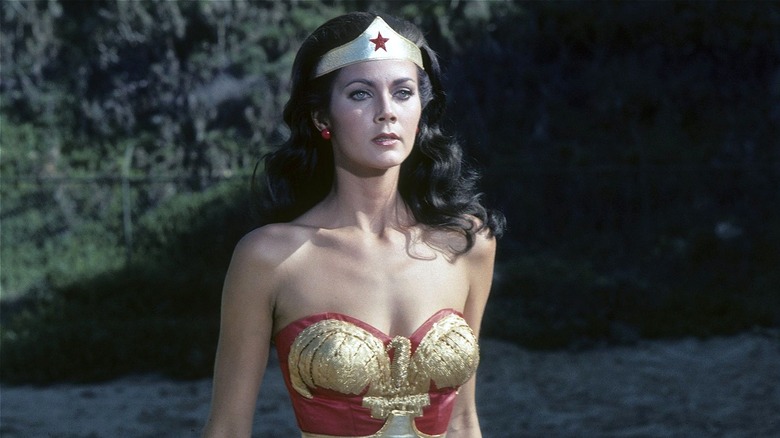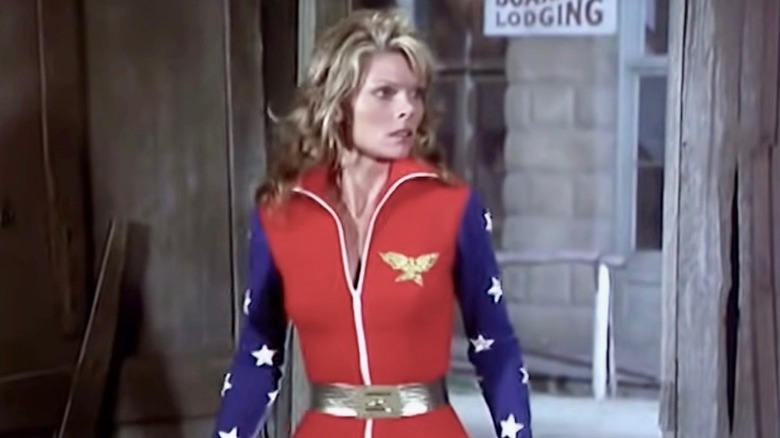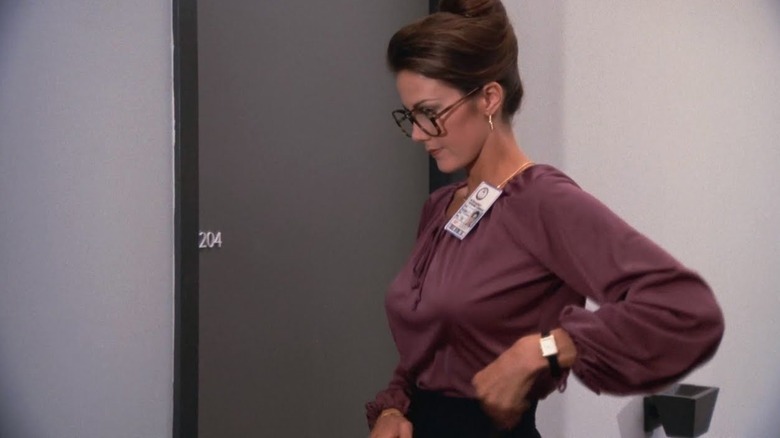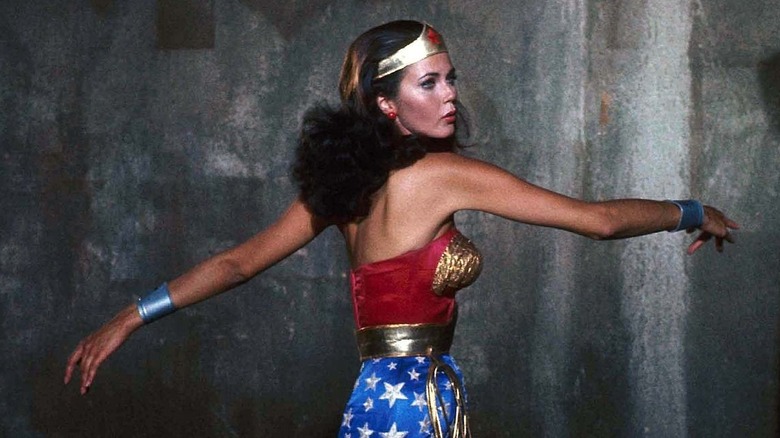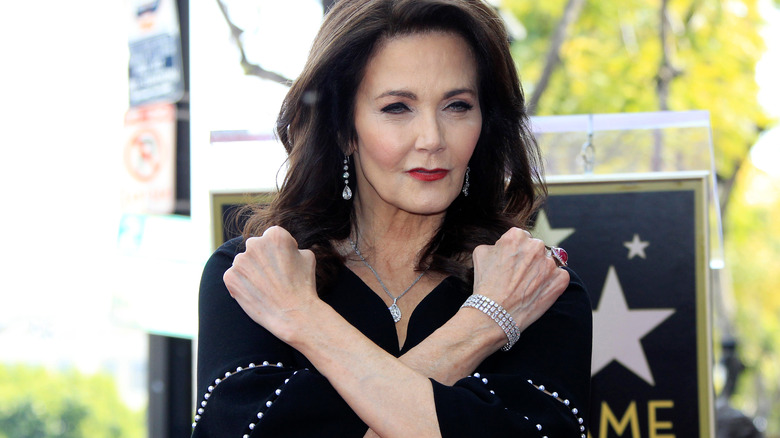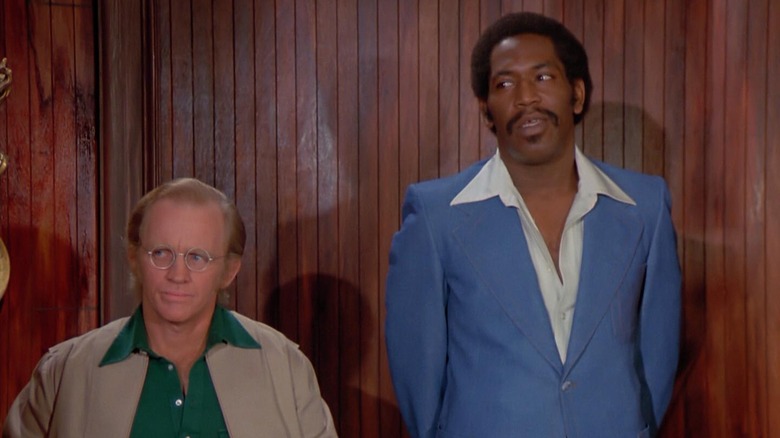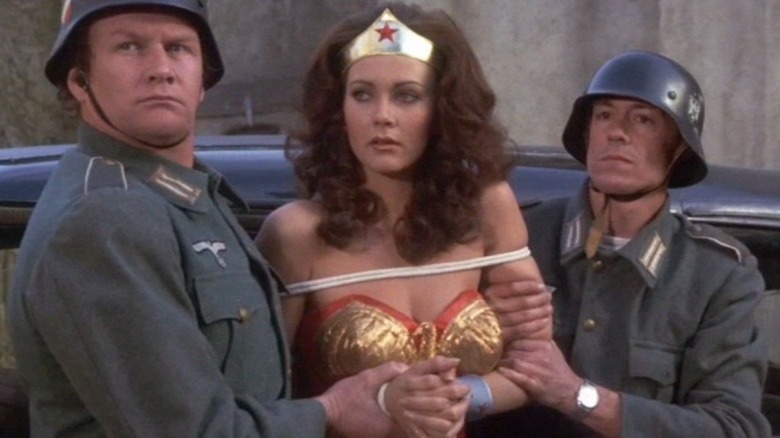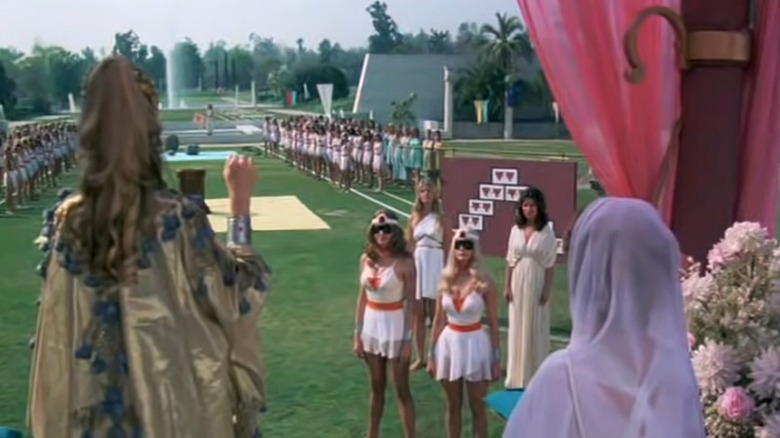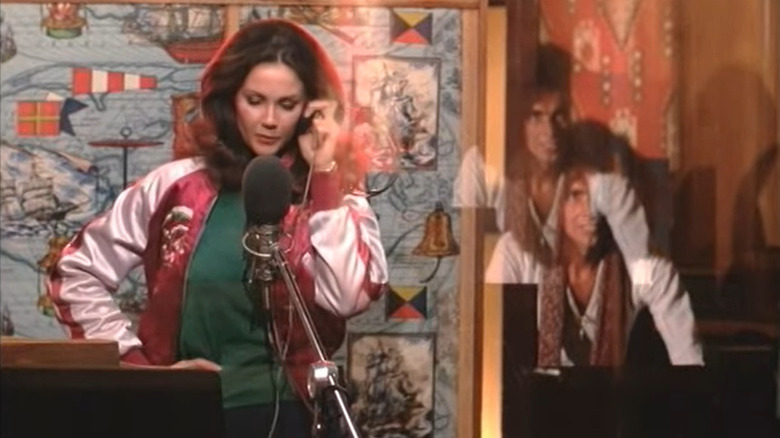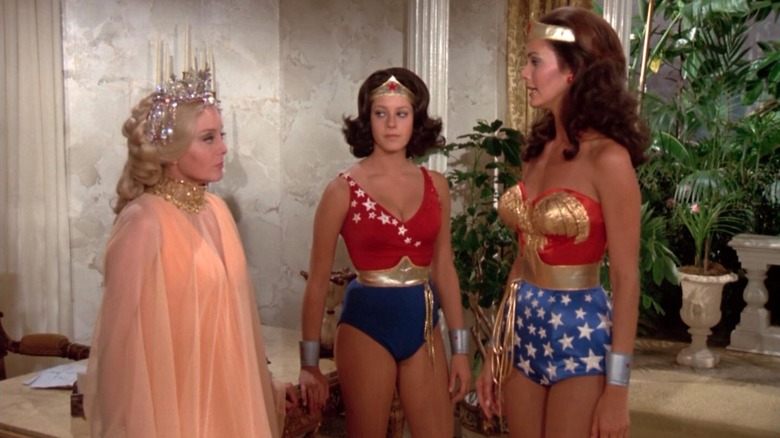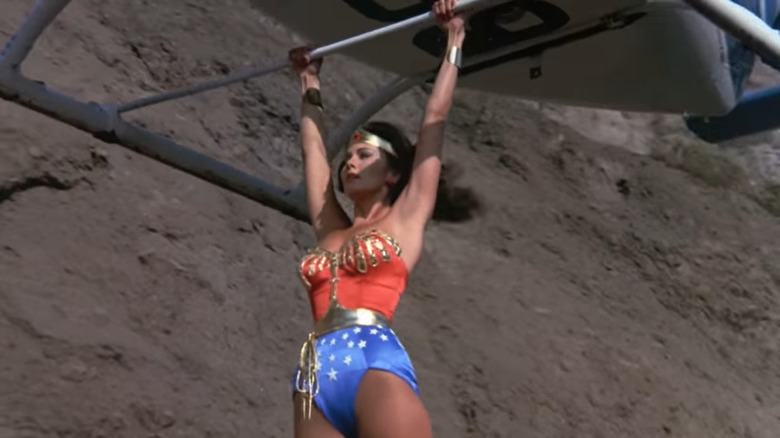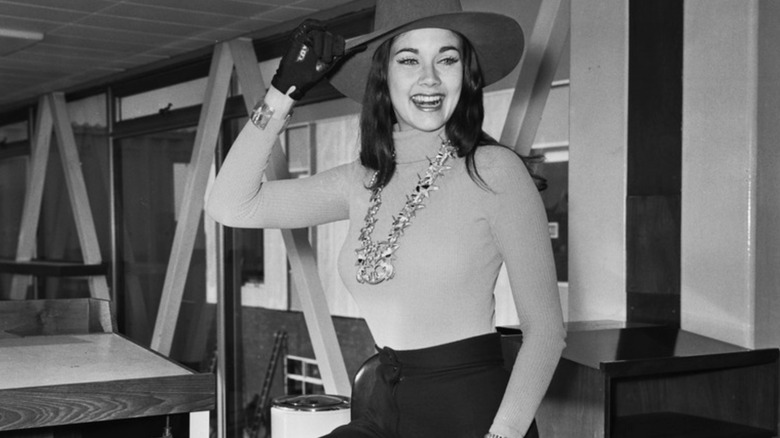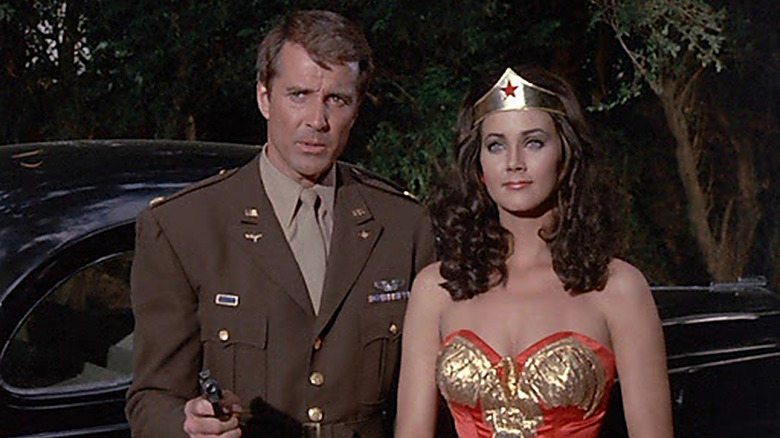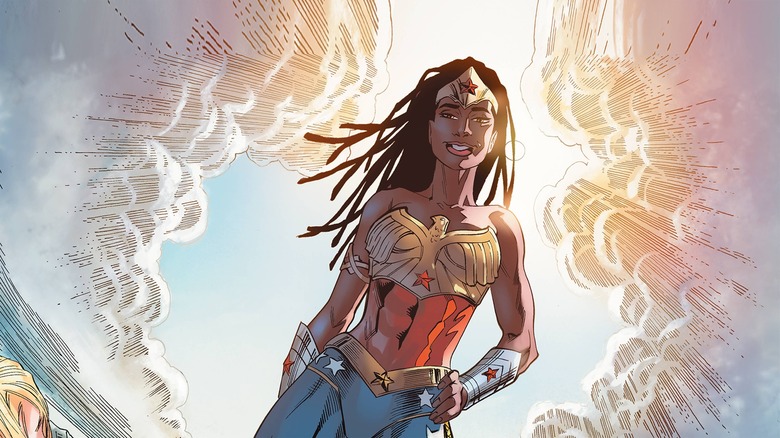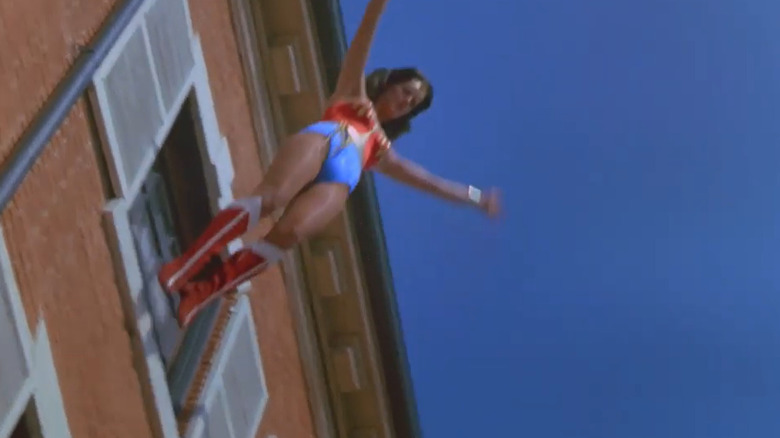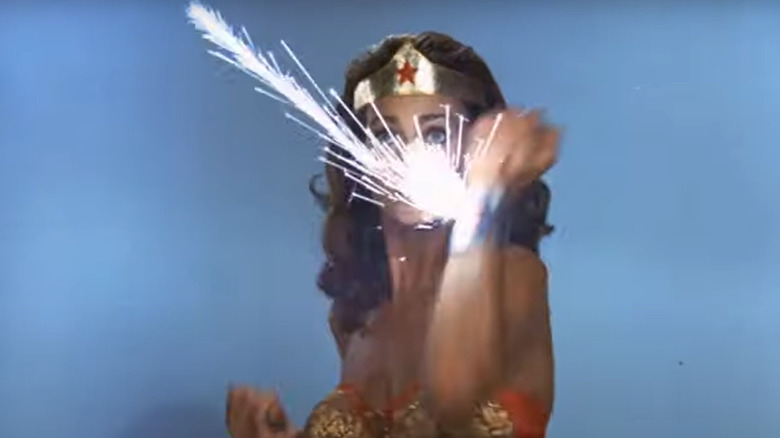The Untold Truth Of The Wonder Woman TV Series
Diana, Princess of the Amazons, aka Wonder Woman, is usually seen as one of DC Comics' flagship characters. Yet despite her importance as a DC character and her position as one of the most well-known superheroes in the world, Wonder Woman has long struggled to get her own solo live-action projects.
Today, many may know the "Wonder Woman" movies starring Gal Gadot as Diana. But decades before that film franchise was ever a thing, the most well-known live-action take on the iconic character was the "Wonder Woman" TV series that ran from 1975 to 1979. The show starred Lynda Carter as the titular superheroine, who saves the day as both Wonder Woman and her less spectacular alter ego, Diana Prince.
In the years since its release, the "Wonder Woman" TV series has come to be seen as a cult classic, which honored the history of the comic book character while also adapting her stories to fit the times and the television medium. Carter's take on Wonder Woman can be considered just as iconic as Christopher Reeve's Superman or Michael Keaton's Batman. Here are some facts about the "Wonder Woman" show that fans might not know.
A long road to creation
Female superheroes have long suffered from the stigma of being considered "unappealing" in leading roles. Both Wonder Woman and Black Widow had to wait decades longer than their male counterparts to get solo movies, despite being famous around the world. That belief about their appeal was even worse in the 1970s.
It also did not help that Wonder Woman has one of the strangest backstories in the superhero world, which involves Amazons, Greek gods, and German soldiers. When Warner Bros. decided to try to bring "Wonder Woman" to the small screen, they attempted to make her more palatable to general audiences. One of the first attempts at this venture resulted in the 1974 television film "Wonder Woman," which stars former professional tennis player Cathy Lee Crosby. She plays a blonde super-spy named Diana, who exhibits no superpowers and lacks most of the character's backstory from the comics.
Even so, this 1974 TV movie was still better than a previous attempt at a live-action "Wonder Woman" series in 1967. The pilot for the series, titled "Who's Afraid of Diana Prince?" features Ellie Wood Walker as Diana Prince, and is a straight-up comedic take on the character. After both these projects failed to generate sufficient interest, the studio decided to make the much more faithful adaptation of the "Wonder Woman" comics starring Lynda Carter.
Diana Prince gets an update
Today, most superheroes in the MCU don't use a secret identity. But DC superheroes have always prioritized keeping their crime-fighting lives separate from their personal lives through disguises. Superman has his mild-mannered and bespectacled alter ego Clark Kent, while few suspect Batman might actually be flashy billionaire Bruce Wayne.
In the comics, Wonder Woman takes the cue from her male counterparts by creating her own secret identity of Diana Prince. Like Clark Kent, Diana Prince wears thick glasses and affects a meek, bumbling persona in order to evade suspicion that she might be an Amazonian superheroine. But on the TV series, Diana Prince — as played by Lynda Carter — is not bumbling at all. She is shown to be as confident and capable as Wonder Woman, albeit in a less flashy way.
Carter insisted on making this change from the comics to bring the character more in line with the feminist sensibilities of the time. "It was about feminism and women's rights," the actress explained in an interview with EW. "[The producers] got a lot of blowback for that. But I said it's ridiculous to dumb [Diana] down. She's not wearing something over her face. You don't suspend belief that [Diana and Wonder Woman are] not the same person. I wanted to make her smart."
Lynda Carter added the iconic spin
One of the most fondly remembered aspects of Lynda Carter's Wonder Woman is the iconic spin that Diana Prince does in order to magically transform into her superhero alter ego. Over the years, this method of transformation has become as intrinsically connected to the character as Clark Kent ripping open his shirt to reveal his Superman costume or Bruce Wayne sliding down the Bat-pole to become the Caped Crusader.
The spin transformation is not an element from the comics, but was designed specifically for the television medium. The team behind the "Wonder Woman" show needed a dramatic and quick way for Diana Prince to become Wonder Woman. While the team was trying to come up with a solution, it was Lynda Carter who suggested the spin transformation based on her experience as a ballet dancer, which often involved doing spins and pirouettes.
"I invented Wonder Woman's spin," Carter explained in a 2005 EW interview. "In the comic book, Diana Prince just left and came back as Wonder Woman. But for the show, they couldn't figure out how I would make the change. I was a dancer, so I said, 'I can do a pirouette or a spin.' They put in the explosion later on." Carter's spinning transformation caught on like wildfire with fans, and became a popular part of Wonder Woman's history in pop culture.
Fighting a real-life villain
On "Wonder Woman," Lynda Carter takes on a plethora of enemies with a quiet confidence, which has inspired generations of fans. In the real world as well, Carter has been an outspoken proponent of women's rights, and has confronted villains directly. One such person happened to be working on the sets of the show, and he showed his noxious side in the grossest manner possible.
In an interview with The Daily Beast, Carter revealed that a member of the crew on "Wonder Woman" had created a secret peephole through which to watch the actress change in between shoots. "There was a cameraman who drilled a hole in my dressing room wall on the Warner Brothers lot," the actress stated. "They caught him, fired him, and drummed him out of the business."
While that issue was eventually resolved, Carter admitted that there were other times when a man would try something with her, and when she called him out on it, he would laugh the whole thing off, "so there was an element of deniability there." It was due to these personal experiences that Carter welcomed the #MeToo movement as a way to start holding predators in the entertainment industry accountable for their misdeeds.
Tossing a guy for real
As a show aimed at general audiences and younger viewers, "Wonder Woman" could not indulge in too many intense action scenes or fisticuffs. For the most part, the titular heroine contents herself with tossing her enemies across the room or tying them up with her golden lasso. But there was one particular actor who did not relish the idea of getting tossed by Wonder Woman.
In the episode "Light-fingered Lady" (Season 2, Episode 13), Diana Prince poses as the jewel thief Lil Thaxton to infiltrate a gang of powerful criminals. Famed footballer Bubba Smith guest stars in the episode as the criminal Rojak, who gets into a tussle with Diana. The scene involves Diana tossing Rojak onto the ground, and Carter told Larry King that the football legend had a problem with being flipped over by a woman.
"We devised this little plan [to execute the scene]," Carter further explained in "The Pioneers of Television: Superheroes" for PBS. "I said [to Bubba Smith] 'Okay, I bet you think I can't do this, but let's just try it ... we won't film it." Smith agreed to what he thought was a trial run, even though the cameras were secretly rolling. Carter was able to successfully toss the much larger and bulkier Smith in that scene, which was later used in the episode. According to the actress, the football legend was "not too happy" with the way the whole thing went down.
The time jump
The first season of "Wonder Woman" was a ratings hit for ABC, but the studio was having a difficult time justifying picking up the show for a 2nd season (via EW). This was because the setting of the show during World War II was deemed too narrow to allow for any other kinds of villains to spice up the proceedings.
"[The studio] believed the WWII storylines were too limiting," Carter stated in an interview with Starlog Magazine. "They thought if we took it into the 1970s, there would be more to explore, from a creative standpoint." Eventually, talks broke down, and ABC passed on picking up the show for another season. This prompted Warner Bros. to pitch the show to CBS, which could use a time-jump to bring Wonder Woman into the modern era. "It was a fresh approach," explained Douglas Cramer, the show's executive producer, "which CBS thought would reach a wider audience."
Thanks to these backdoor negotiations, when Wonder Woman returned to TV with her 2nd season, some 30-odd years were shown to have passed since the events of Season 1. Princess Diana still looked the same, thanks to her Amazonian biology. But the cast around her was replaced, with the exception of Lyle Waggoner, who played Steve Trevor in Season 1. Waggoner now portrayed the son of the original Steve Trevor, who happened to look exactly like his father.
A little piece of Paradise
Although she is operating in Man's World (and mostly in America), Wonder Woman belongs to a hidden race of warrior women called Amazons, who live on Themyscira, aka Paradise Island. While this island was brought to life in an epic manner in 2017's "Wonder Woman" live-action film, the studio behind the "Wonder Woman" TV show did not build the world of Themyscira so grandly.
In fact, Themyscira isn't shown very often on the "Wonder Woman" series. One of its most prominent appearances is in the pilot episode, which shows the Amazons holding a contest to determine who will venture forth into Man's World as an ambassador to spread a message of peace and unity to other civilizations.
The version of Themyscira that shows up onscreen looks less like a sprawling island and more like a really nice garden. That's because that is what it actually was: The scenes for Paradise Island were shot at The Arboretum of Los Angeles County. The Arboretum contains wildlife, waterfalls, and a large lagoon, all of which worked to present a respectable depiction of Themyscira.
Diana the singer
Before becoming Wonder Woman, Lynda Carter was crowned Miss World USA in 1972. She then represented the U.S. at the 1972 Miss World pageant and finished in the top 15, so making the jump to film and television was perhaps a natural course for her. But before being known for her beauty and her acting skills, Carter was a singer with a strong passion for music and songwriting.
According to a profile in The Washington Post, Carter would sing at the local pizza parlor when she was just 15. It was a good way of making money, and after high school, she toured with a band around the US. Even after getting the role of a lifetime as Wonder Woman, Carter's love for music and songwriting did not diminish.
The actress found a way to showcase her musical talent on the series. In the episode "Amazon Hot Wax" (Season 3, Episode 16), Diana Prince goes undercover as a singer named Kathy Meadows. While playing the part, Diana sings a song titled, "Toto (Don't It Feel Like Paradise)." It's a song that Carter wrote, and it appeared on her album, "Portrait," which had been released around the same time in 1978 (via AllMusic).
Wonder Girl pranks Letterman
One aspect of "Wonder Woman" that tends to get overlooked is the fact that Carter's Wonder Woman was briefly joined by a teenage sidekick: Drusilla, aka Wonder Girl. Drusilla was played by 15-year-old Debra Winger, who would later go on to a distinguished career in movies like "An Officer and a Gentleman" (1982) and "Terms of Endearment" (1983).
Drusilla is Diana's younger sister, who is sent to Man's World by their mother to find Diana and bring her back to Paradise Island. Even though she only showed up in three episodes, Winger's portrayal of Drusilla proved to be such a hit with audiences that executive producer Doug Cramer wanted to do a Wonder Girl spin-off series (via Starlog Magazine). But instead, the actress moved on to more prominent roles on the big screen since "the last thing she wanted to do was be stuck in a series." Later in her career, Winger rarely mentioned her time on the show, but she seemed to have a sense of humor about it.
During an interview with David Letterman where he had Winger on as a guest, the host showed a clip of Wonder Girl in action. While she initially seemed to be embarrassed, Winger did not let Letterman know she had actually come prepared for this "surprise" clip. At the end of the interview, Winger took off her dress to reveal her old Wonder Girl outfit. She then proceeded to run across the studio to the exit, leaving a "shocked" Letterman in her wake (via EW).
The stunt that went too far
While Lynda Carter was a talented singer and beauty queen, playing Wonder Woman involved a great action skills the actress hadn't yet honed. Still, Carter was game to try anything when it came to the action scenes, and her enthusiasm almost caused a problem with the studio. The usual process in Hollywood is to have a stunt double perform the dangerous parts of an actor's performance with the help of a disguise.
The issue on "Wonder Woman" was that Carter cut such a striking and unique figure with her height and daring outfit that, as Carter noted to The Daily Mail, it was often difficult for a stuntman to be able to pass himself off as Carter in an action scene (and yes, men were sometimes used as her doubles). This proved particularly problematic in a scene where Wonder Woman is supposed to grab on to a helicopter's undercarriage and get carried along with the machine into the air.
Shooting the scene with a stunt double — man or woman — would not work because the face was clearly visible the whole time, so Carter decided to do the hair-raising stunt herself. And she did so without a safety harness that could protect her if her hands slipped. The actress pulled off the stunt smoothly, but got in trouble with the studio, who were not happy that their lead actress had put her life (and the entire show) in danger doing something so risky (via The Daily Mail).
Not just a heartthrob
As soon as Lynda Carter stepped in front of the television screen wearing the iconic red, blue, and gold Wonder Woman outfit, audiences worldwide swooned. Yet, for Carter, being a heartthrob was never the goal.
The actress has made it clear that for her, the joy of playing Wonder Woman was portraying a strong and independent woman, who could inspire young girls rather than be the object of fantasies for young men. "I still have women at airports coming up to me saying, 'Oh, you don't know what it meant to me. That show got me through this difficult time, that difficult time,'" Carter told The Columbus Dispatch while talking about the impact her character had on female fans.
She goes on to add, "If a guy comes up and says, 'Oh my God, I had such a crush on you when I was a teenager,' I say, 'Talk to the hand. I don't want to know.'" In the same interview, Carter gets asked about Wonder Woman's "skimpy" outfit that seems almost designed to titillate men rather than empower women. In response, the actress points out that male superheroes are not held up to the same standard, since characters like Superman also wear body-hugging outfits that show off their physiques at every turn.
Trouble in Paradise?
Since "Wonder Woman" is a show about women saving the day, Lynda Carter's male co-star, Lyle Waggoner, had the slightly thankless task of playing the less interesting love interest of Diana. In Season 1, Waggoner played Steve Trevor, and in later seasons, he portrayed Steve Trevor Jr. However, Waggoner pulled off his duties with a style and grace that turned Steve into Diana's equal onscreen rather than just her sidekick.
But this unusual power dynamic between the male and female leads of "Wonder Woman" — all the more remarkable because the show was made in the 1970s — did take a toll on the relationship between Waggoner and Carter. In an interview during the 3rd season of the show, Waggoner addressed the fact that his character was getting less and less screen time with each passing episode. "Just say," the actor told TV Guide with respect to his leading lady co-star, "the spotlight is not willing to be shared" (via Wonderland).
For her part, Carter has always denied any tension with Waggoner on the sets of "Wonder Woman." In later years, the two spoke cordially of each other as Carter has noted that Waggoner was "so chipper on set" (via Starlog Magazine). When Waggoner passed away in 2020, Carter took to Instagram to pay tribute to her former co-star, stating, "Lyle Waggoner was a memorable colleague and co-star, but he was also a friend."
We almost got a Black Wonder Woman
The ethnicity of heroes has always been a matter of hot debate. There was that whole online debacle over the casting Michael B. Jordan as the Human Torch in 2015's "Fantastic Four." Wonder Woman has always been seen as a white woman, even though Lynda Carter is half-Mexican, and Gal Gadot was born and raised in Israel.
That is not to say there have not been attempts to add more diversity to the legend of Wonder Woman. Yara Flor is a popular future depiction of Wonder Woman from the comics, who originally comes from Brazil. Back in 2008, Beyoncé expressed interest in playing Wonder Woman. And several decades before that, DC Comics introduced the character of Nubia, a Black Amazon, who was Wonder Woman's sister.
Nubia was already a part of the comics when the "Wonder Woman" television series was made, and the producers planned to put the character in the show. There were even rumors that the makers wanted path-breaking Black actress Teresa Graves to play Nubia (via Black America Web). Unfortunately, the character never made it onto the series, and all we have to imagine what could have been is the image of a "Nubia" doll that had been made as part of the show's merchandise.
A game-changer for stunt women
"Wonder Woman" is an action-packed series, but it was made at a time when there were very few women doing stunt work. Most stunts were being done by men dressed up as female characters. But this approach would not have worked for Wonder Woman, whose flashy costume and distinctive body required a female double for Carter.
And so, "Wonder Woman" employed a host of stuntwomen, and opened up doors to take a stuntwoman's association to the next level in the entertainment industry. "One of the things I'm most proud of is that my show [helped in the early years to promote] a stuntwomen's association," Lynda Carter told EW in an interview. "The stunt – women's union. [Before that,] they didn't have women doing stunts, they had men doing stunts in wigs."
The most prominent stuntwoman, who frequently filled in for Carter during action scenes, was the legendary Jeannie Epper. Carter and Epper had a strong bond during their time on the show. It was so strong that when Epper's son's classmates refused to believe his mom was Wonder Woman, Carter invited the entire class to watch an episode of the show being filmed, just so they could see Epper in action.
The trick of the bullet-deflecting bracelets
One of the most iconic aspects of Wonder Woman's mythology (besides her tiara) are her arm bracelets, which the superheroine uses to deflect bullets at superhuman speeds. The "Wonder Woman" television series is famous for frequently exhibiting this aspect of Wonder Woman's fighting style, with Diana using her bracelets to fend off attacks from armed gunmen.
In modern times, such scenes would be carried out with the help of CGI. But that was not an option at the time that the show was being made. The makers of the series had to rely on good, old-fashioned practical special effects to make it look like Diana was actually deflecting bullets off her bracelets.
"It was done with buttons ... I had wires coming up into my hands," Carter revealed in an interview with Johnny Carson. With this mechanism, Carter would press the button to activate white sparks on the surface of her bracelets whenever she needed to make it look like her character was deflecting bullets.
